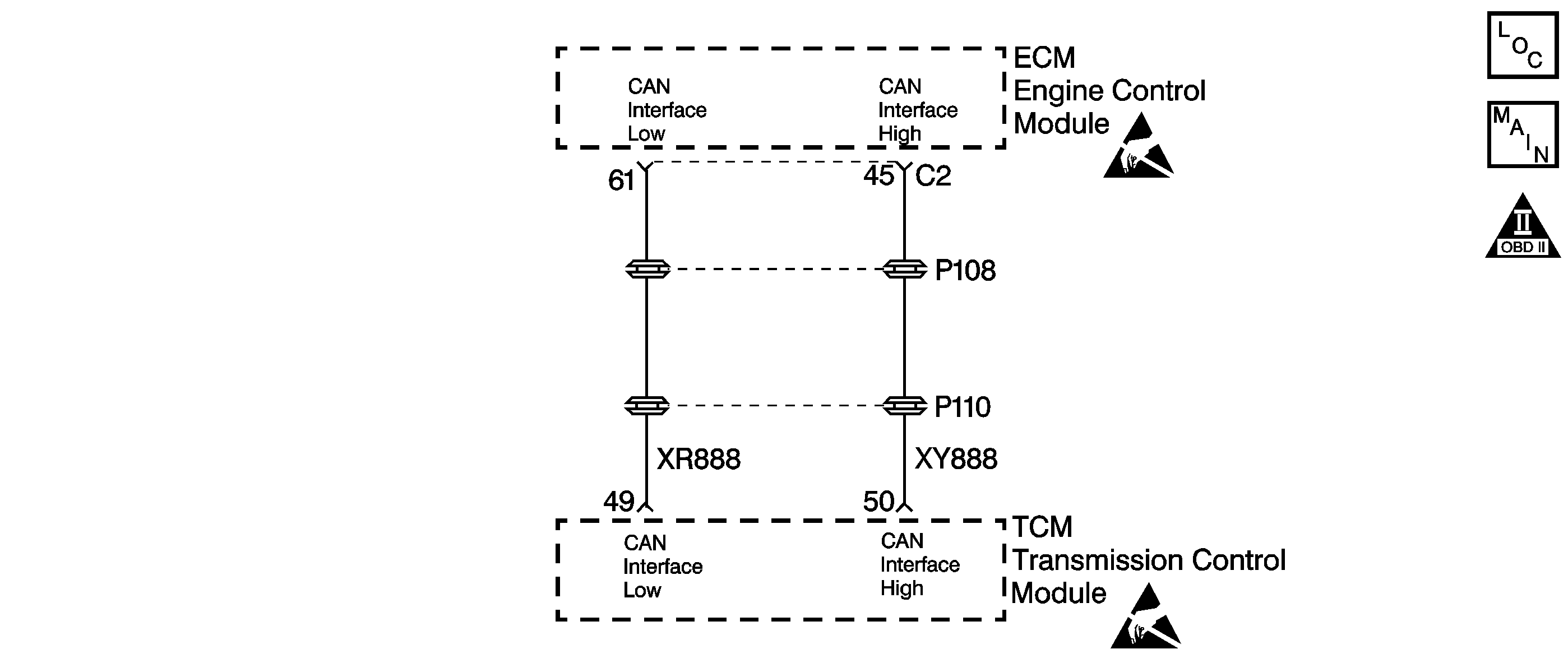
Circuit Description
Engine torque information (signal) is sent to the transmission control module (TCM) by the engine control module (ECM) through a communication network called controller area network (CAN). Circuits XR888 and XY888 are used to communicate CAN data between the ECM and TCM control modules.
When the ECM sends the TCM an engine torque signal that is below the lower limit, above the upper limit, or is an unreliable value, then DTC P1781 will set. DTC P1781 is a type C DTC.
Condition for Running the DTC
The ignition switch is in the RUN position.
Condition for Setting the DTC
Engine torque signal is below the lower limit, above the upper limit, or is an unreliable value for 1 second.
Action Taken When the DTC Sets
| • | Early production - The TCM illuminates the service transmission lamp (STL). |
| • | Late production - The TCM flashes the Sport Mode Lamp. |
| • | The ECM records the operating conditions in the Failure Records at the time of the request from the TCM. |
| • | The TCM memory stores the DTC at the time of the first failure. |
Conditions for Clearing the STL/DTC
| • | Early production - The TCM turns off the STL as soon as the fault is no longer present. |
| • | Late production - The TCM stops flashing the sport mode lamp as soon as the fault is no longer present. |
| • | A History DTC clears after forty consecutive warm-up cycles, if no failures are present by this diagnostic or any other emission related diagnostic. |
| • | The scan tool clears the DTC. |
| • | The TCM cancels the DTC default mode actions when the fault no longer exists and the ignition switch is Off long enough in order to power down the TCM. |
Diagnostic Aids
Vehicles equipped with Fuel Cap Lamps utilize the Sport Mode lamp to indicate a transmission malfunction. In these vehicles, the Sport Mode Lamp flashes at 200 millisecond intervals when the TCM commands the lamp ON.
Vehicles not equipped with Fuel Cap Lamps are equipped with a dedicated Service Transmission Lamp (STL) on the Instrument Panel Cluster (IPC). The STL illuminates steadily when the TCM commands the lamp ON.
Use the J 35616-A connector test adapter kit for any test that requires probing the TCM harness connector or a component harness connector. Using this kit will prevent damage to the harness connector terminals. Check for the following conditions:
| • | Poor connections at the TCM or at the component. Inspect the harness connectors for any backed out terminals, improper mating, broken locks, improperly formed or damaged terminals, and poor terminal to wire connection. |
| Refer to General Electrical Diagnosis in Wiring Systems for proper procedure. |
| • | Damaged harness. Inspect the wiring harness for damage. If the harness appears to be OK, observe the scan tool while moving any related connectors and any wiring harnesses. A change in the display may help to locate the fault. |
Test Description
The numbers below refer to the step numbers on the diagnostic table.
-
This step verifies the torque value is present.
-
This step checks for engine DTCs that would normally set if engine torque conditions were detected.
Step | Action | Value(s) | Yes | No |
|---|---|---|---|---|
1 | Was the Powertrain On-Board Diagnostic (OBD) System Check performed? | -- | ||
Important: Before clearing the DTC, use the Scan Tool in order to record the Failure Records. Using the Clear Info function erases the Failure Records from the ECM/TCM. Does the engine torque increase when the accelerator is slightly depressed and decrease when the accelerator is released? | -- | Go to Diagnostic Aids | ||
Check for any ECM DTCs. Are there ECM DTCs present? | -- | -- | ||
4 | Go to the appropriate ECM DTC. Make the necessary repairs. Refer to Engine Controls. Are the DTC repairs complete? | -- | Go to Engine Controls | |
5 | Perform the following procedure in order to verify the repair:
Does DTC P1781 reset? | -- | System OK |
